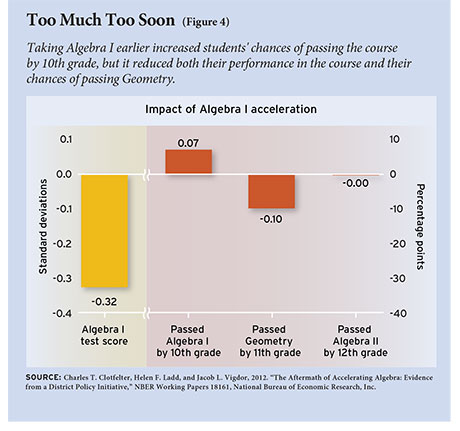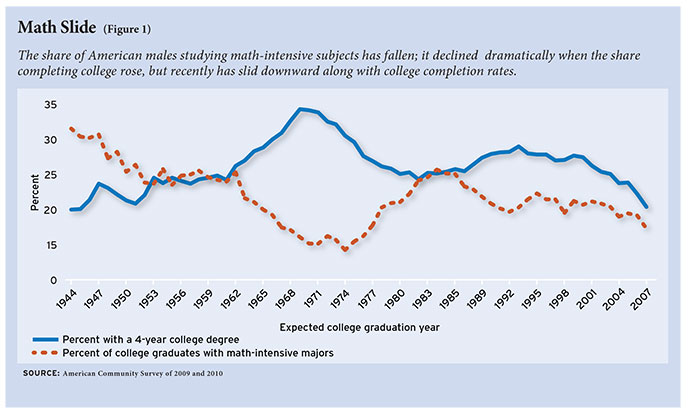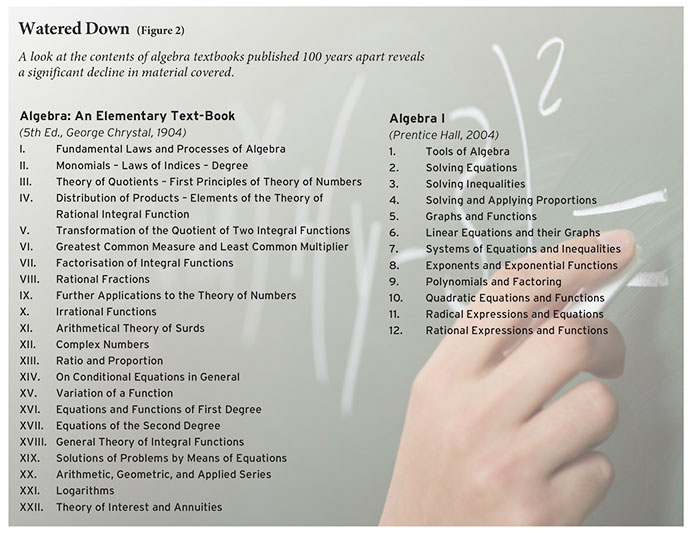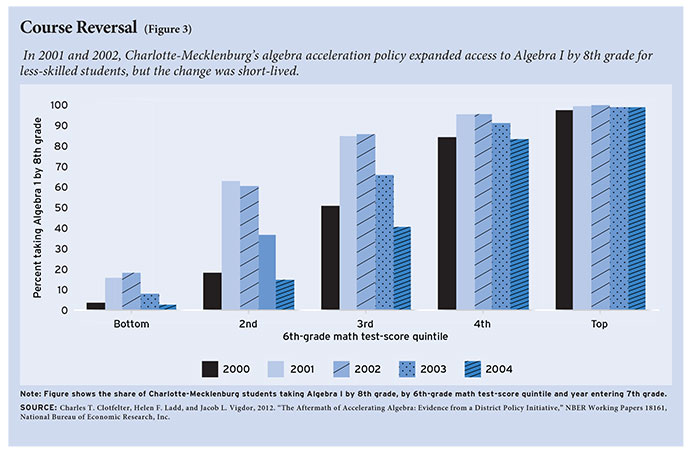 In the 21st-century workplace, mathematical capability is a key determinant of productivity. College graduates who majored in subjects such as math, engineering, and the physical sciences earn an average of 19 percent more than those who specialized in other fields, according to the American Community Survey of 2009 and 2010. Precollegiate mathematical aptitude matters as well: math SAT scores predict higher earnings among adults, while verbal SAT scores do not.
In the 21st-century workplace, mathematical capability is a key determinant of productivity. College graduates who majored in subjects such as math, engineering, and the physical sciences earn an average of 19 percent more than those who specialized in other fields, according to the American Community Survey of 2009 and 2010. Precollegiate mathematical aptitude matters as well: math SAT scores predict higher earnings among adults, while verbal SAT scores do not.
These facts help explain our national focus on improving math performance. International comparisons made possible by standardized testing reveal just how American students lag behind their global peers (see “Are U.S. Students Ready to Compete?” features, Fall 2011). Judging the nation purely by its own historical performance yields the same conclusion. Between 1972 and 2011, real GDP per capita doubled in the U.S., but the average math SAT score of college-bound high-school seniors and the proportion of college graduates majoring in a mathematically intensive subject barely budged.
Concern about our students’ math achievement is nothing new, and debates about the mathematical training of our nation’s youth date back a century or more. In the early 20th century, American high-school students were starkly divided, with rigorous math courses restricted to a college-bound elite. At midcentury, the “new math” movement sought, unsuccessfully, to bring rigor to the masses, and subsequent egalitarian impulses led to new reforms that promised to improve the skills of lower-performing students. While reformers assumed that higher-performing students would not be harmed in the process, evidence suggests that the dramatic watering down of curricular standards since that time has made our top performers worse-off. Even promised improvements in the lower part of the distribution have at times proved elusive, a point illustrated below by the disappointing results of a recent initiative to accelerate algebra instruction in the Charlotte-Mecklenburg school district.
America’s lagging mathematics performance reflects a basic failure to understand the benefits of adapting the curriculum to meet the varying instructional needs of students. Recently published results from policies such as Chicago’s “double dose” of algebra, which groups students homogeneously and increases instructional time for lower-skilled math students (see “A Double Dose of Algebra,” research, Winter 2013), support differentiation as the best way to promote higher achievement among all students.
Decades of Hand Wringing
Figure 1 uses data from the American Community Survey of 2009 and 2010 to track a basic indicator of math proficiency over a 75-year span: the proportion of college graduates who majored in a math-intensive subject (math, statistics, engineering, or physical sciences) in each cohort. The sample is limited to male college graduates in order to address possible concerns about changing gender composition of the college-graduate population, although the figure looks similar if females are included.
Fluctuations in this indicator over time support a basic argument: American attempts to homogenize the math curriculum in secondary schools, although sometimes successful at improving the performance of the average student, have come at the cost of preparing the nation’s most promising students for mathematically intensive study.
At one point in time, 3 college graduates in 10 majored in a math-intensive subject. These cohorts grew up in an era when advanced math topics—algebra, geometry, and trigonometry—were considered “intellectual luxuries,” worthy of instruction to a select few, but of little to no relevance for the vast majority of the workforce. From the 1930s through the mid-1950s, educational practice codified these beliefs. Less than one-third of all high-school students enrolled in algebra, substantially fewer in geometry, and only 1 in 50 proceeded to trigonometry.
Among cohorts educated in the post–World War II era, there have been three distinct periods of decline in this measure of math performance. The first decline is modest and occurred very soon after World War II. Students graduating in the 1950s and early 1960s majored in math-intensive subjects less often than those graduating in the late 1940s. Trends in college completion, also shown in Figure 1, suggest that this early decline in math intensity corresponds with a run-up in college attendance and completion associated with the GI Bill. Given the restriction of advanced mathematical training to a select group of high school students in the first half of the century, it’s reasonable to think that the expansion of college access, presumably to less-prepared students, explains this first decline.
Expansion of access might explain a portion of the much larger decline occurring between 1962 and 1974. But the access and math-intensity trends don’t line up perfectly, and changes in enrollment and completion rates are not sufficiently large to explain the full decline in math intensity in these years.
If the admission of mathematically marginal students can’t explain this decline in math-intensive study, what can? One might hypothesize that math-intensive subjects are subject to “fads,” implying that college enrollment fluctuations have little to do with the underlying ability of students. The midcentury decline in math intensity, however, occurs at a time when math-intensive study should have enjoyed great popularity. The graduating class of 1974 commenced its formal education immediately following the Soviet launch of Sputnik in 1957, and graduated from high school shortly after the United States put a man on the moon. Nevertheless, this cohort chose math-intensive majors at roughly half the rate of classes from the 1940s.
The midcentury decline in math intensity coincides with the rise of the “new-math” movement. This movement to improve the math skills of average students was sparked in part by national security concerns. During World War II, many rank-and-file soldiers were unable to calculate the trajectory of artillery shells, among other things, in an era when hand computation in the field was still a necessity. The Cold War–era “arms race” and “space race” amplified calls to steer more American students toward math, science, and engineering. The new-math movement reflected a shift in curriculum design from professional educators to professional mathematicians. Where “old math” was pragmatic, focusing students’ efforts on tasks they were likely to perform in the course of their future careers, “new math” valued mastery of fundamental concepts, some of them quite abstract. It is during the new-math era, for example, that calculus was introduced as a high school subject, albeit only for a select group of students. Ironically, a curricular reform designed to introduce new rigor and bring higher-order subjects to more students in secondary school appears to have resulted in a strong movement away from math at the collegiate level.
Given that the substitution of rigor for practicality appears to have turned students off to math, it stands to reason that substitution in the reverse direction would undo the effect. And indeed, the wane of the new-math movement in the late 1960s and early 1970s might explain the resurgence of interest in math-intensive majors, the only such episode observed over a period of 75 years, among those graduating from college in the late 1970s and early 1980s.
The resurgence was short-lived. From the 1984 class onward, the proportion of college graduates completing math-intensive majors dropped steadily. This second major decline in math intensity reflects a second nationwide effort to improve the math performance of average students. The alarm bells sounded by the influential A Nation At Risk report in 1983 pointed not to the performance of the elite but rather to the prevalence of remedial education in colleges and universities. It lamented the fact that a small fraction of high school students managed to complete calculus, in spite of the fact that most attended a school that offered the course.
Six years after A Nation At Risk, the National Council of Teachers of Mathematics introduced new standards that favored calculators over pencil-and-paper computations, cooperative work over direct instruction, and intuition over solution algorithms. Educational rhetoric of the “No Child Left Behind” era has continued to prioritize the performance of average or even below-average students. The proficiency standards mandated by the No Child Left Behind Act impose sanctions on schools that fail to serve their worst-performing students, but enact no penalty on schools that accomplish this goal by shifting resources away from their top performers. Studies have verified the predictable consequence: gains to students just below the proficiency level have in some settings been offset by losses among more-advanced students.
No Improvement in High School
Evidence from the National Assessment of Educational Progress (NAEP) provides further indication that curricular reforms have improved performance in basic subjects without providing a stronger foundation for more advanced study. Successive waves of testing show that students born in 1981, for example, outperformed the 1977 birth cohort at ages 9 and 13, but had lost their advantage by the time they reached 17. The performance of American 15-year-olds on the Programme for International Student Assessment (PISA) exam in 2000 and 2009 confirms the lack of progress among secondary school students. The United States is among those countries whose math performance worsened over this time period. American students also fell behind those from several other countries: Luxembourg, Hungary, Poland, and Germany. International comparisons focused on younger students, such as the Trends in International Mathematics and Science Study (TIMSS), however, show more signs of progress in the United States relative to other nations.
This evidence of stagnation among secondary school students seems at odds with statistics on the math course–taking patterns of American students. In the mid-1980s, about one student in six took Algebra I in middle school. In more recent years, the national average has been closer to one-third, a doubling over the course of a generation. In some areas, including California and the District of Columbia, the majority of students take Algebra I as 8th graders.
How can students simultaneously proceed to advanced coursework earlier and perform no better on national and international assessments? Figure 2 yields some insight by listing the tables of contents for two introductory algebra textbooks: George Chrystal’s fifth edition, published in 1904, and Algebra 1, published by Prentice Hall exactly one century later. While there are similarities in the curricula outlined by these books—both, for example, cover quadratic equations late in the manuscript—the early book covered many more topics in greater detail. There is no mention of series in the later book, nor logarithms, interest and annuities, complex numbers, or exponential functions beyond the quadratic. Ironically, the only topic covered in greater detail in the 2004 textbook is inequality—of the mathematical variety.
A distaste for inequality has clearly motivated mathematics curricular reforms over the past quarter century. While the intent of equality-minded reforms is to boost low-performing students, in the case of American mathematics achievement, decline among higher-performing students has been part of the bargain. Furthermore, results from Charlotte’s algebra acceleration initiative indicate that an unthinking pursuit of equality can in fact harm all students, not just those at the top.
The Charlotte-Mecklenburg Algebra Initiative
This section summarizes research I undertook with Duke University colleagues Charles Clotfelter and Helen Ladd. The complete report, available as a working paper from the National Bureau of Economic Research, studies the impact of an algebra acceleration initiative in one of North Carolina’s largest school districts.
North Carolina’s Charlotte-Mecklenburg School (CMS) district is generally regarded as a model education agency. It serves more than 100,000 students, ranking among the 30 largest in the United States. Among the 18 large school districts identified in 2009 NAEP assessment results, CMS ranked first in 4th-grade math performance, the only large district to post scores exceeding the national average. The district covers an entire county, incorporating both urban and suburban communities. While it is more affluent than most large districts in its NAEP peer group, it has a higher student poverty rate than North Carolina as a whole. A majority of students in the district are either black or Hispanic.
A decade ago, CMS superintendent Eric Smith instructed middle school principals to enroll a larger proportion of students in Algebra I, the first course in the state’s college-preparatory high-school sequence. He told PBS that middle school math is “the definition of what the rest of the child’s life is going to look like academically.” His goal was to “make sure that kids were given that kind of access to upper-level math in middle school.”
Figure 3 documents the impact of the policy initiative, using administrative data on CMS students from the North Carolina Education Research Data Center. It divides students into five groups of roughly equal size (quintiles), based on their performance on the state’s end-of-grade math assessment as 6th graders. Students are further divided into five age cohorts.
Students whose 6th-grade test scores place them in the top quintile of the distribution are consistently likely to take Algebra I by 8th grade. For students closer to the middle of the 6th-grade distribution, however, Algebra I enrollment rates varied considerably across cohorts. In the cohort entering 7th grade in 2000–01, about half of moderately performing students (those between the 40th and 60th percentile) took Algebra I as 8th graders; low-performing students in the same cohort had virtually no chance of taking algebra in middle school.
Over the next two years, the effect of Smith’s algebra policy can be readily observed. Moderately performing students in the 2002–03 7th-grade cohort had an 85 percent chance of taking Algebra I as 8th graders; even the lowest-performing students had a one-in-six chance.
Just as quickly as the policy was introduced, a return to the status quo appears in the data. The cohort of students entering 7th grade in 2004–05 took Algebra I in 8th grade at rates similar to or even lower than their counterparts in the first cohort. One might conclude from the rapid reversal that the policy did not lead to the anticipated effects. We’ll present the evidence on that score momentarily.
Smith’s initiative was inspired by basic observational evidence. In the United States, as elsewhere, students observed taking advanced courses at an early age tend to accomplish more later in life. In a later interview, Smith cited evidence documenting higher rates of AP course completion and better SAT scores among students who had taken Algebra I by 8th grade. But to infer from this that early entry benefits students, one must assume that the students in the advanced courses were no different from their counterparts, on average, before taking the course. This assumption is clearly misguided. As Figure 3 shows, those who in 2000 had the highest math scores in 6th grade (the top two quintiles) were much more likely than those with lower scores to take Algebra I by 8th grade. While it is theoretically possible that early progression to advanced coursework compounds this advantage, empirically it is very difficult to disentangle this benefit from the profound baseline differences between early and late algebra takers.
 The CMS policy initiative provides a rare opportunity to perform this disentangling. Moderately performing students born just two years apart were subjected to radically different algebra placement policies. Were students in the accelerated cohort more likely to perform well in Algebra I? In the standard follow-up courses of Geometry and Algebra II? Figure 4 summarizes the evidence, which is based on student performance on North Carolina’s standardized end-of-course tests in the three subjects. The analysis on which the figure is based isolates the impact of Algebra I acceleration by comparing the performance of otherwise identical students who were subject to different placement policies by virtue of belonging to different age cohorts.
The CMS policy initiative provides a rare opportunity to perform this disentangling. Moderately performing students born just two years apart were subjected to radically different algebra placement policies. Were students in the accelerated cohort more likely to perform well in Algebra I? In the standard follow-up courses of Geometry and Algebra II? Figure 4 summarizes the evidence, which is based on student performance on North Carolina’s standardized end-of-course tests in the three subjects. The analysis on which the figure is based isolates the impact of Algebra I acceleration by comparing the performance of otherwise identical students who were subject to different placement policies by virtue of belonging to different age cohorts.
Students perform significantly worse on the state’s Algebra I end-of-course test when they take the course earlier in their career. The decline in performance is approximately one-third of a standard deviation, or 13 percentile points for an average student. The course material forgone in the acceleration process, plus the additional maturity that comes with a year of age, contribute positively to Algebra I performance.
The decline in end-of-course test performance implies that students’ risk of failing the course increase when they are accelerated. One could adopt a relatively sanguine view, arguing that accelerated students who have to retake the course ultimately aren’t any worse-off than those who weren’t accelerated in the first place. And the second effect shown in Figure 4 supports this view, showing that in spite of their worse performance, accelerated students actually become a bit more likely to pass the course on a college-preparatory schedule, that is, no later than their 10th-grade year. For most of these students, the acceleration provided three chances to pass the course rather than two.
It’s a different story when we consider the next outcome: whether students manage to pass the state’s end-of-course test in geometry by the end of their 11th-grade year. Accelerated students were 10 percentage points less likely to meet this threshold, in spite of the fact that acceleration gave them two chances, rather than one, to retake a course in the event they did not receive a passing grade.
By forgoing a year of prealgebraic math, students miss an opportunity to receive some instruction in fundamental topics underlying geometry. Although certain topics in geometry flow naturally from algebra—translating an equation with two unknowns into a line in a two-dimensional plane, for example—there are others that do not. In North Carolina’s standard curriculum, geometry incorporates emphasis on area and volume calculations, trigonometric functions, and proof writing, topic areas with zero coverage in the standard Algebra I curriculum.
To complete the college-preparatory curriculum in North Carolina, students must at a minimum pass the set of courses culminating in Algebra II. Accelerated students were neither more nor less likely to clear this hurdle by the time they would ordinarily complete 12th grade. The data show that many accelerated students who passed Algebra II did so without ever passing Geometry, implying that they had not completed the full college-preparatory math sequence. The struggles of accelerated students undoubtedly explain why CMS so rapidly reversed course, returning to its initial placement policy after only two years of acceleration.
Policy Implications
American public schools have made a clear trade-off over the past few decades. With the twin goals of improving the math performance of the average student and promoting equality, it has made the curriculum more accessible. The drawback to exclusive use of this more accessible curriculum can be observed among the nation’s top-performing students, who are either less willing or less able than their predecessors or their high-achieving global peers to follow the career paths in math, science, and engineering that are the key to innovation and job creation. In the name of preparing more of the workforce to take those jobs, we have harmed the skills of those who might have created them. Although there is some evidence of a payoff from this sacrifice, in the form of marginally better performance among average students, some of the strategies used to help these students have in fact backfired.
To some extent, the nation has reduced the costs of this movement through immigration. Foreign students account for more than half of all doctorate recipients in science and engineering, two-thirds of those in engineering. Many of these degree recipients leave the country when they finish, however, limiting their potential benefit to native-born Americans. Immigration policy reform that emphasizes skills over traditional family reunification criteria, much like the policies in place in Australia, Canada, and other developed nations, could change this pattern.
A second possible policy option would be to implement a curricular reform more radical than tinkering with the timing of already existing courses. Many schools have adopted the so-called “Singapore math” model, which emphasizes in-depth coverage of a limited set of topics. There are concerns, however, regarding whether a curriculum developed in a different cultural and educational context could produce similar results here. Singapore’s public schools, for example, use a year-round calendar, obviating the need to review basic subjects after a summer spent out of the classroom. Evidence also indicates that Singapore’s teachers have a firmer grasp of math than their American counterparts.
The United States need not import its science and engineering innovators, however. It need not borrow a faddish curriculum from a foreign context. And it need not sacrifice the math achievement of the average student in order to cater to superstars. It need only recognize that equalizing the curriculum for all students cannot be accomplished without imposing significant lifelong costs on some and perhaps all students.
Curricular differentiation might, for its part, exacerbate test-score gaps between moderate and high performers, if high performers move ahead more quickly. A narrow-minded focus on the magnitude of the gap, however, can lead to scenarios where the gap is closed primarily by worsening the performance of high-achieving students—bringing the top down—without raising the performance of low-achieving students. Society’s goal should be to improve the status of low-performing students in absolute terms, not just relative to that of their higher-performing peers. A growing body of evidence suggests that this type of improvement is best achieved by sorting students, even at a young age, into relatively homogenous groups, to better enable curricular specialization. Recent results from Chicago, cited above, provide evidence that differentiating the high school mathematics curriculum can have long-run benefits, even for students assigned to remedial coursework.
Not all children are equally prepared to embark on a rigorous math curriculum on the first day of kindergarten, and there are no realistic policy alternatives to change this simple fact. Rather than wish differences among students away, a rational policy for the 21st century will respond to those variations, tailoring lessons to children’s needs. This strategy promises to provide the next generation of prospective scientists and engineers with the training they need to create jobs, and the next generation of workers with the skills they need to qualify for them.
Jacob Vigdor is professor of public policy and economics at Duke University.
This article appeared in the Winter 2013 issue of Education Next. Suggested citation format:
Vidgor, J. (2013). Solving America’s Math Problem: Tailor instruction to the varying needs of the students. Education Next, 13(1), 42-49.





